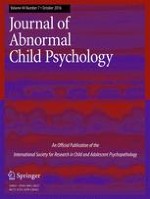28-12-2015
Affiliation with Socially Withdrawn Groups and Children’s Social and Psychological Adjustment
Gepubliceerd in: Research on Child and Adolescent Psychopathology | Uitgave 7/2016
Log in om toegang te krijgenAbstract
This 1-year longitudinal study examined the effects of membership in socially withdrawn peer groups on children’s social and psychological adjustment in a sample of 979 children (417 boys, 562 girls, M age = 11.84 years). Data on children’s social and psychological adjustment and problems were collected from peer nominations and self-reports in the fall and spring of a single academic year. Using the Social Cognitive Map, 162 peer groups were identified. Multilevel analyses showed that affiliation with withdrawn groups negatively predicted social competence and school attitude, and positively predicted victimization and depression. The results suggest that affiliation with socially withdrawn groups is a risk factor for the development of social and psychological problems.
